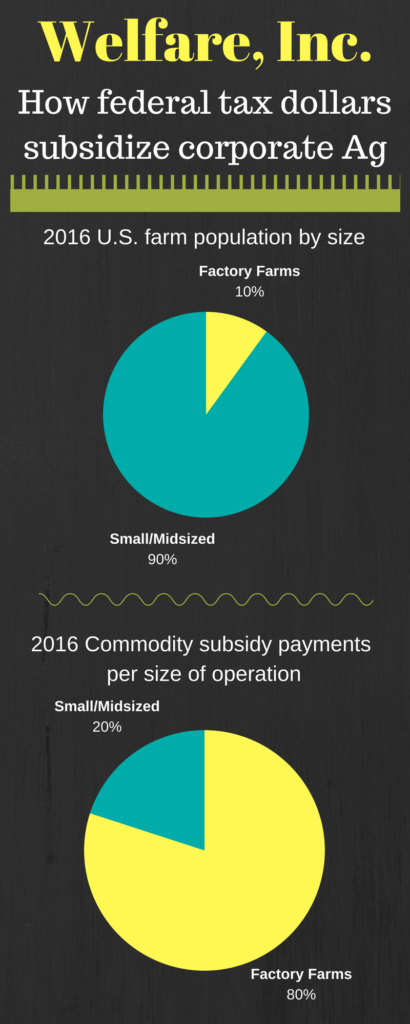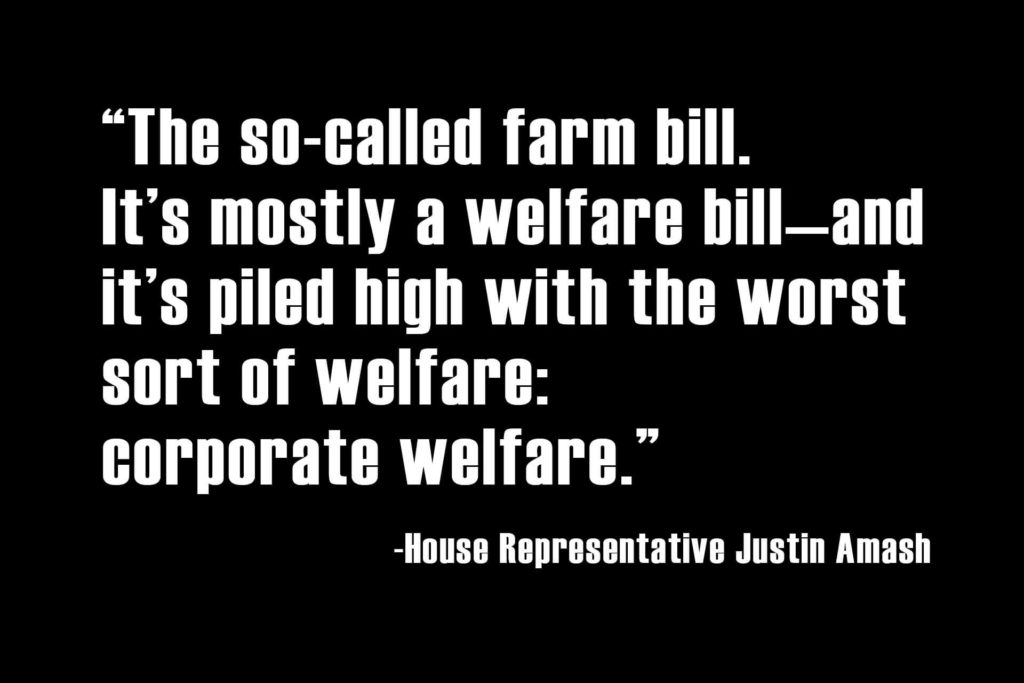The H.R.2 sequel takes food from needy kids and money from rural communities in order to subsidize factory farms.
The vote is expected to be very close, and your voice can make a huge impact. Contact your Representative and demand they stand up for rural America and real farmers and ranchers. Demand Congress end the corporate handouts and wasteful spending and focus on policy that puts Main Street before Wall Street, and people before profits. Demand Congress vote “NO” on H.R.2.
UPDATE June 21, 2018 at 4:24 p.m.: The House passed its version of the Farm Bill by a 213-211 vote. We’ll work up a list of Representatives from our network’s districts for accountability’s sake, and we’ll continue tracking the Farm Bill process. Huge shout-out to our action-takers and those of you who reached out to your Representative throughout this effort!
The House Farm Bill is back for another vote, most likely tonight.
Yes, it’s that House Farm Bill, the one that cuts social welfare with one hand and doles out billions in corporate welfare with the other. Last month, that House Farm Bill was torpedoed by a bipartisan coalition of conservative Republicans and all the House Democrats.
But, it’s back, thanks to some parliamentary sleight of hand, ready as ever to take food out of the mouths of hungry children so that it can line the pockets of large corporate agribusiness. Make no mistake, this bill is a bad deal for real farmers and rural communities, and here’s why.
First, a primer. For a more detailed breakdown on the Farm Bill in general, check out this link. But, here’s the CliffsNotes version. The Farm Bill is a package of government legislation which creates programs that touch the lives of almost every American. It began during the Dust Bowl and the Great Depression, and was part of the New Deal. It must be updated or extended every five years, or it and the programs in it expire. These programs include things like crop insurance, government loans, education, food stamps, and soil and water conservation, to name a few. It’s intended to offer support to America’s heartland, and the hardworking people who do the thankless job of feeding the nation.
But lately, it doesn’t do that so much.
Lately, lobbyists working for massive corporate agribusiness interests have embedded themselves in the process, cozied up to Congressional officials, and captured pieces of the federal regulatory system. Lately, the Farm Bill is written by, for, and in the interest of the deepest pockets in town.
 Why is the 2018 House Farm Bill so bad?
Why is the 2018 House Farm Bill so bad?
The House bill is a prime example of this trend taken to the extreme. Among other things, it:
-
- Provides more money for Concentrated Animal Feeding Operations (CAFOs).
-
- Raises Farm Service Agency loan caps, which makes them less available to small- and mid-sized farms, and more lucrative to large operations and CAFOs.
-
- Contains loopholes that allow non-farmers to collect up to $125,000 in commodity subsidies for being tangentially related to a farm business. In some cases, distant relatives of large operation managers are collecting these checks without ever setting foot on a farm.
-
- Eliminates the Conservation Stewardship Program.
-
- Cuts funds for promoting farmers’ markets and other producer-to-consumer markets.
-
- Slashes value-added producer grants that help beginning and socially disadvantaged farmers.
-
- Cuts funding for renewable rural energy development.
-
- Makes it easier to market new pesticides without considering the impact on pollinators.
-
- Precludes states and municipalities from passing more-stringent health and environmental rules.
-
- Eliminates public input and environmental review on a wide range of activities on public lands.
-
- Preempts state and municipalities from passing food safety and packaging rules.
- And, it cuts funding for, and adds more regulations to the Supplemental Nutrition Assistance Program (SNAP, aka food stamps). However there’s not likely a net savings here for the government, because the tax dollars saved by trimming welfare recipients will be spent on administering the new requirements the bill writes into the program.
Clearly, the House Farm Bill contains a lot to be alarmed about. But the growing trend of subsidizing the wealthiest players is probably the most shocking. And, it’s not new.
How has the Farm Bill subsidized Big Ag?
The conservative think tank, the American Enterprise Institute, published a 2018 paper that found 68 percent of subsidized federal crop insurance payments from 2014-2015 went to the top 10 percent of farms in terms of crop sales. The study also found similar results for cash subsidies. More than 80 percent of those federal dollars went to the top 20 percent of farms. In essence, the government is forking out your tax dollars to the most successful operations. And, it’s done so by an alarming margin.
A year later, that trend accelerated. In 2016, 27 percent of commodity payments went to small family farmers — those folks represent 90 percent of all American farms. They also pulled down a meager 17 percent of crop-insurance protection. Alternatively, seventy-three percent of commodity payments and 83 percent of crop-insurance indemnities went to the largest 10 percent of farms.
Moreover, the watchdog Environmental Working Group (EWG) published a study that shows the wealthiest farm operations raked in an average $116,501 in subsidies in 2016. Meanwhile, the average farmer got a mere $2,479.
The EWG concluded that large operations boosted their incomes by $13 billion because of loopholes and redundancies in the 2014 bill. Those same loopholes and redundancies are still in the 2018 bill, the only difference is that there’s more money to fund them now.
All this represents Big Ag’s corporate lobby dollars hard at work. Between 2012 and 2014 — as the current, expiring Farm Bill was being drafted, more than 600 companies expended $500 million lobbying Congress on agricultural policy.
The House Farm Bill is so all-around bad, it has drawn ire from both the Koch brothers’ conservative advocacy group, Americans for Prosperity, and the environmentally-focused Sierra Club. The Koch brothers went so far as to call out the bill’s “corporate welfare provisions and wasteful spending,” warning Congressional members that their vote will be factored into their legislative scorecard.
How can the Farm Bill better serve real farmers?
The Western Organization of Resource Councils opposes the bill for being completely counter to its Farm Bill Platform. WORC believes an ideal Farm Bill should :
-
- Invest in local and regional food system development.
-
- Strengthen and protect commodity market competition.
-
- Ensure fair access to credit and insurance for small- and mid-sized operations.
-
- Protect healthy families’ access to nutritious food.
-
- Reinstate sound supply control practices that smooth out boom-and-bust cycles.
-
- Promote conservation.
-
- Invest in public research for the public good.
- And, develop rural renewable energy solutions.
What can you do about it?
The House plans to vote on the bill this evening (Thursday, June 21). The vote is expected to be very close, and your voice can make a huge impact. Contact your Representative and demand they stand up for rural America and real farmers and ranchers. Demand Congress end the corporate handouts and wasteful spending and focus on policy that puts Main Street before Wall Street, and people before profits. Demand Congress vote “NO” on H.R.2.
Read more stories about agriculture and food here.

